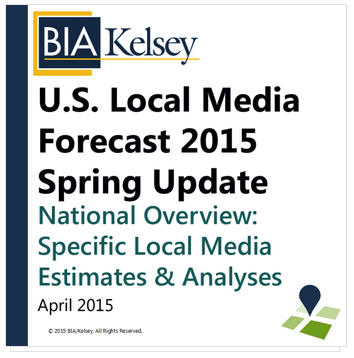Local ad spending reached $137.9 billion in 2014, and will see a slight boost to $139.4 billion in 2015. We talked with BIA/Kelsey Chief Economist and SVP Mark Fratrik about the new research (interview below).
Every year, BIA/Kelsey issues a five-year forecast on local spending in the fall, and then updates it in the following spring based on full year reporting, current trends and anticipated events.
This year’s update shows more spending than originally forecast in 2014, and modest increases in our 2015 given several factors, including a rapid rise in mobile spending.
BIA/Kelsey: We’re seeing a slight uptick from our original forecasts for 2014-2015. What’s driving that?
Mark Fratrik: Local TV spending was stronger in 2014 than we predicted, primarily due to political advertising from many Senate, House and gubernatorial races. And television still drives local political spending, even though its overall growth rates are much lower than online. Television growth rates average 3-4 percent. Online growth is always in double digits, but starts at a much smaller base. To be sure, we aren’t downplaying the shift from traditional advertising to more digital/online/mobile outlets. These new media provide a more focused and efficient advertising vehicle for national and local advertisers to reach their audiences. The shift is especially felt in traditional print outlets, such as newspapers.
BIA/Kelsey: Hundreds of millions of dollars, if not billions, are being raised for the next presidential election. Won’t that drive spending with local television outlets?
Mark Fratrik: We should see an amazing amount of spending coming up in late 2015 into early 2016-15. With a tightly competitive Presidential race on the Republican side, it won’t just be in the early stats of Iowa, New Hampshire, Nevada and South Carolina. And we want to make the point again about online and digital. While political campaigns are increasingly using digital outlets, local TV and cable still see a much larger part of that spending. They’re an important part of that message building.
BIA/Kelsey: The big new local channel is mobile. We see how the Internet pure plays like Google, Facebook and Yahoo are reporting that mobile revenues are moving towards parity with other digital advertising.
Mark Fratrik: Mobile is driving most of the change in the digital space, gaining traction with advertisers, and jumping to an 11.5 percent share of the media pie by 2019 from 3.1 percent a year ago. We are constantly updating and increasing our estimates for mobile spending . By 2019, it will be the fourth highest channel for local media spending in terms of share. Mobile is also driving our increased forecast for social media spending, which will grow by almost 1/3, or 31 percent.
BIA/Kelsey: We’re seeing a lot of activity for digital audio services like Pandora, I Heart Radio and Spotify. How much will they impact local spending, and especially, traditional radio?
Mark Fratrik: Radio is a good illustration of the gap between digital and traditional media revenues. Take Pandora. It will generate nearly $153 million in 2014 in local advertising revenue, which represents really healthy growth. But that is just $153 million of $139 billion in local media spending. And it is only in the Top 50 markets. Conversely, Radio stations continuously to basically hold its own with $14.4 billion in over-the-air advertising spending in 2015, or 10.3 percent.



This Post Has 0 Comments